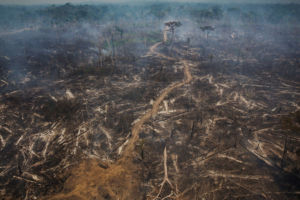The following article points out that no matter how successful the negotiations are in Paris in December, they will be totally insufficient to limit the impacts a warming climate will have on civilization to a tolerable level. But progress is progress. It is very significant that there is beginning to be a worldwide consensus that we must make commitments to start down the path to mitigate and limit the impact of the coming catastrophe.
As the UN Secretary General Ban Ki-moon told world leaders on Sunday, “Paris must be the floor, not the ceiling, for collective ambition”.
Personally, I am actually very excited and encouraged about where we are today. Undoubtedly, while our kids and grandchildren are going to bear the brunt of our neglect for the last 20 years when it was becoming extremely clear what the consequences of our inaction was going to be, the world is at least taking tentative steps in the right direction. And like my grandson who is now hard to stop from running anywhere at full speed, not too long ago he was just taking his first tentative steps and finding out what he was capable of doing.
As stated by “Gavin A. Schmidt, head of the NASA unit in Manhattan that studies climate change, … the history of environmental cleanup suggested that once countries got started on the problem, they would discover that solving it was cheaper and easier than expected.” I know that this will be the case.
The article states, “Yet the analysis also shows that the nations are still a far way from meeting their own shared target, set in 2010, of limiting global warming to about 3.6 degrees Fahrenheit. That level of warming, while potentially producing dire effects on agriculture, sea level and the natural world, might at least be tolerable, some experts believe.”
Tolerable is a relative term. The Pentagon warned us 20 years ago that Climate Change was going to be the largest threat to world peace pitting nations against each other as they battle over the lack of water and food that will be impacted by a warming climate. And we can already see the terrible truth of this phenomenon today when you look at the horrible human tragedy playing out in the Middle East in brutal conflict and mass migration.
You may think that it is stretch for me to point to climate change as the root cause of all this turmoil but there are a lot of people that are a great deal smarter than I am that believe this. What we’re seeing now is just the tip of the iceberg.
Nevertheless, I am encouraged that we are finally waking up to the fact that we MUST take action. And I am also confident that once the ball gets rolling it will only pick up steam and we will move much more quickly than most people can comprehend.
Buckle up. Huge changes are coming and with increasing speed.
Limited Progress Seen Even as More Nations Step Up on Climate
By JUSTIN GILLIS and SOMINI SENGUPTA
SEPT. 28, 2015
An area of the Amazon rain forest burned to make way for pasturelands. Brazil has pledged to end illegal deforestation. Credit Lalo de Almeida for The New York Times
The pledges that countries are making to battle climate change would still allow the world to heat up by more than 6 degrees Fahrenheit, a new analysis shows, a level that scientists say is likely to produce catastrophes ranging from food shortages to widespread extinctions of plant and animal life.
Yet, in the world of global climate politics, that counts as progress.
The new figures will be released Monday in New York as a week of events related to climate change comes to an end. The highlight was an urgent moral appeal at the United Nations on Friday from Pope Francis, urging countries to reach “fundamental and effective agreements” when they meet in Paris in December to try to strike a new global climate deal.
For much of this year, countries have been issuing pledges about how much emissions they are willing to cut in coming decades. With a plan announced by Brazil on Sunday, every major country except for India has now made a commitment to take to the Paris conference.
An analysis by researchers at Climate Interactive, a group whose calculations are used by American negotiators and by numerous other governments, is expected to be released Monday and was provided in advance to The New York Times. It shows that the collective pledges would reduce the warming of the planet at century’s end to about 6.3 degrees, if the national commitments are fully honored, from an expected 8.1 degrees Fahrenheit, if emissions continue on their present course.
That would be the biggest reduction in the history of global climate politics, and a sign that 20 years of disappointing negotiations may be giving way to an era when countries start to move the needle on the projected global temperature.
Yet the analysis also shows that the nations are still a far way from meeting their own shared target, set in 2010, of limiting global warming to about 3.6 degrees Fahrenheit. That level of warming, while potentially producing dire effects on agriculture, sea level and the natural world, might at least be tolerable, some experts believe.
The pledges countries have made “are a big step forward, but not sufficient — not even close,” said John D. Sterman, a professor of management at the Massachusetts Institute of Technology. Climate Interactive, a Washington organization with extensive ties to M.I.T., receives foundation money to build tools that help governments and the public understand climate policy.
Making any serious pledge has been a political challenge in many countries, including the United States, where President Obama has encountered vociferous opposition in Congress. Governments are unlikely to want to reopen those fights in the remaining two months before the Paris talks. Thus, many analysts expect that any final deal struck in Paris will probably not be enough to forestall dangerous levels of global warming.
“Everyone is now convinced there will be agreement in Paris,” President François Hollande of France said Sunday afternoon at the United Nations. “But the question is, what kind of agreement?”
Despite the uncertainty, optimism is growing among some diplomats and scientists that progress has become possible. Intensive engagement between China and the United States over the past two years helped break the logjam in global climate politics, and for the first time, virtually every country is now offering to pitch in to help limit emissions growth.
Janos Pasztor, United Nations assistant secretary general for climate change, said the task in Paris would be to put mechanisms into the deal to encourage countries to ramp up their ambitions over time. Requirements for periodic reviews and fresh pledges are under discussion as a potential part of the agreement.
At a luncheon that the United Nations secretary general, Ban Ki-moon, hosted for dozens of world leaders on Sunday, the heads of state and government “agreed that Paris must be the floor, not the ceiling, for collective ambition,” Mr. Ban said afterward.
Gavin A. Schmidt, head of the NASA unit in Manhattan that studies climate change, said that the history of environmental cleanup suggested that once countries got started on the problem, they would discover that solving it was cheaper and easier than expected.
“By the time people get 10, 15 years of actually trying to do something, that’s going to lead to greater expertise, better technology, more experience,” Dr. Schmidt said. “People will then say, ‘Oh, you know what? We can commit to do more.’ ”
The planet has already warmed by about 1.5 degrees Fahrenheit above the temperature that prevailed before the Industrial Revolution, representing an enormous addition of heat. Virtually every piece of land ice on Earth is melting, the sea ice in the Arctic is collapsing, droughts and other weather extremes are intensifying, and the global food system has shown signs of instability.
At a meeting in Cancun, Mexico, in 2010, climate negotiators from nearly 200 countries agreed that they would try to limit the warming to 3.6 degrees Fahrenheit, or 2 degrees Celsius, above the preindustrial temperature, a level that would require that emissions from fossil fuels largely cease within a few decades.
Subsequently, recognizing that many governments were reluctant to agree to binding limits, the diplomats essentially asked each country to volunteer its best efforts. That decision, controversial at the time, has unlocked a willingness by many nations to participate, including countries like China that had long resisted climate deals.
India is the biggest holdout so far, but that nation’s environment minister, Prakash Javadekar, said in an interview in New York on Sunday that a plan would be submitted to the United Nations on Oct. 1, the eve of the national celebration of Mahatma Gandhi’s birthday — apparently an effort to limit domestic criticism that India is bowing to Western pressure. The plan is not expected to include a target year for India’s emissions to peak, but will be “anchored” by a major commitment to renewable energy, Mr. Javadekar said.
Last week, China announced plans for a nationwide system that would put a price on emissions of greenhouse gases. Brazil became the latest major country to pledge action, on Sunday, with a plan that makes it the first large developing nation to offer an absolute cut in emissions over the next decade, instead of just restraints on continued growth. Brazil also committed to ending illegal deforestation and to restoring millions of acres of degraded forest.
Bruising fights are still expected at the Paris conference, especially over money. Poor countries that have had little to do with causing global warming, but are likely to suffer the worst effects, are demanding billions from rich countries to help them manage.
Moreover, protests are expected from advocacy groups, island countries threatened with inundation, and many others over the perceived inadequacy of the deal. At a minimum, these groups are likely to demand strong procedures for ratcheting up national commitments over time.
“No one doubts that coming out of Paris, there’s going to be an ambition gap on the table,” said Alden Meyer, who follows climate negotiations for the Union of Concerned Scientists, in Washington. “The question is going to be, what prospect do we have to shrink it, and how quickly?”
Coral Davenport contributed reporting.
A version of this article appears in print on September 28, 2015, on page A1 of the New York edition with the headline: Progress Seen on Warming, With a Caveat. Order Reprints| Today’s Paper|Subscribe





